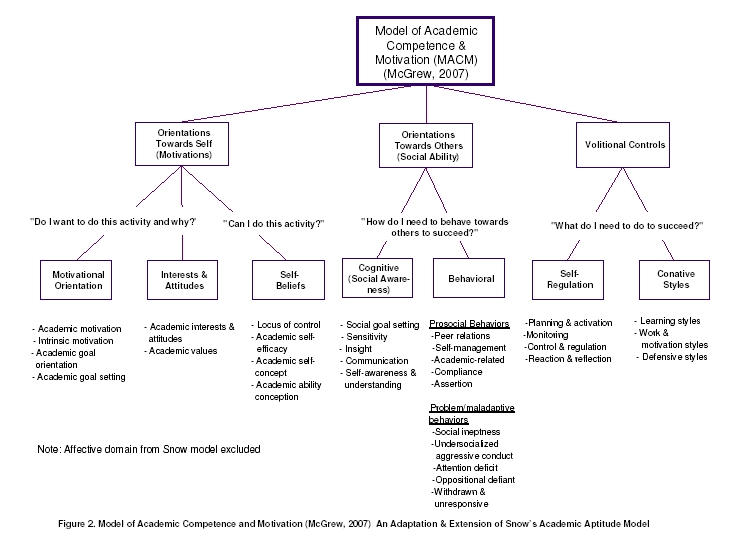An Adapted Version of the Snow
Model
Although a variety of models of school learning
have been articulated (see Haertel et al., 1983, for a review), it
is only recently that a model with sufficient breadth and depth has
emerged with the potential to serve as a “bridging”
mechanism between educational and psychological theory/research and
educational practice. Based on a systematic program of educational
research, the integration of the extant literature (which included
a review of four existing taxonomies; Snow, 1973), and an emphasis
on the relatively stable constructs causally related to educational
performance, Richard Snow ventured a provisional taxonomy (Corno et
al., 2002; Snow, Corno & Jackson, 1996) .
Figure 2 presents a proposed and adapted version
of the Snow Academic Aptitude Model (SAAM). Although the
broad strokes of the SAAM are drawn primarily from the writings of
Snow and colleagues, based on the contemporary literature review
completed for the current document, it was found necessary to
modify portions of the model and/or the model’s
terminology. For example, Corno et al. (2002) describe and
present learning orientation under the sub-domain of motivational
orientation. Most contemporary motivation research
refers to this construct as academic goal orientation (see
Anderman, Austin & Johnson, 2002). In this adapted and
extended model the more contemporary achievement goal
orientation terminology is used. Where necessary and appropriate,
modifications are made to the original SAAM terminology to reflect
contemporary research and writings.
In addition, a contemporary literature review
uncovered specific behaviors and/or skills not included in the
broad-stroke SAAM. These “newcomer” domains were
logically placed under the SAAM category that appeared most
appropriate. For example, relatively new research surrounding
the construct domain of thinking dispositions (Perkins,
Tishman, Ritchhart, Donis & Andrade, 2000) is related to a
learner’s ability conception (Dweck,
2002).
The meaning of the MACM variables presented in
Figure 2 are amplified by the four categories of questions proposed
by Wigfield and Eccles (2002).
-
Do I
(does she/he) want to do this activity and why? Learner
characteristics related to this question include, but are not
limited to, achievement interests and values, intrinsic motivation,
academic goal orientation, and social goals and their relations to
motivation. Obviously, learners who have repeated consistent
school failure would, as a group, be predicted to respond in the
negative to this question.
-
Can I
(he/she) do this activity? When pondering this question,
learners reflect on a number of motivational self-beliefs (e.g.,
self- confidence, academic self- concept, academic self- efficacy)
that have dominated social cognitive models of motivation research
the past three decades. Although germane to all learners,
this question is particularly salient for learners who have
experienced repeated academic failure (e.g., learners with
disabilities, disadvantaged learners).
-
What
do I (does she/he) need to do to succeed? High motivation
and positive self-beliefs are necessary but insufficient conditions
for succeeding in educational environments. A bridge must
link cognitive/academic abilities and motivation with actual
behavior. The primary link is the presence of self-regulated
learning strategies (e.g., study skills, cognitive and learning
strategies, engagement, adaptive help-seeking) that allow
individuals to manage efforts to accomplish their
goal.
-
How do
I (does he/she) need to behave towards others to succeed?
Traditionally U.S. schools have valued student characteristics such
as citizenship, conformity to social rules and norms, cooperation,
and positive social behavior (Wentzel, 1993). The learner who does
not know how (or who lacks the appropriate skills) to behave
appropriately and responsibly is at increased risk for academic
failure.

Finally, the recent version of the SAAM makes
little mention of the domain of social ability, an ability that was
touched on in earlier articulations of the SAAM (under the category
of orientation towards others). As noted by Snow et al.
(1996), psychologists have historically displayed a strong interest
in the construct of social intelligence, which is typically defined
as the ability to act wisely in interpersonal relations and being
sensitive towards others (Thorndike, 1920). Educators
and researchers have consistently demonstrated the importance of
prosocial behavior and social skills to learner success (O'Sullivan
& Guilford, 1975; Wentzel, 1989).
Social ability has two primary dimensions:
“the ability to decode social information, including the
ability to understand nonverbal cues and make accurate social
inferences, and the ability to behave adaptively and effectively in
social situations” (Snow et al., 1996, p. 278). These
two dimensions roughly correspond to the cognitive (internal mental
processes) and behavioral (observable behaviors) components of
social functioning. As presented in Figure 2 (a larger and
more readable version of Figure 2 can be found in the "Key Tables
and Figures" section of this document/resource), a
cognitive-behavioral social ability distinction is made in
the model. .

